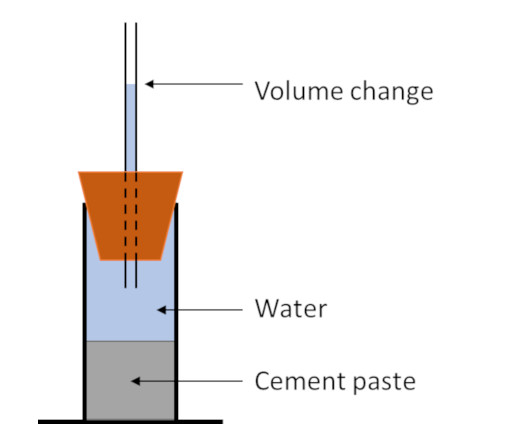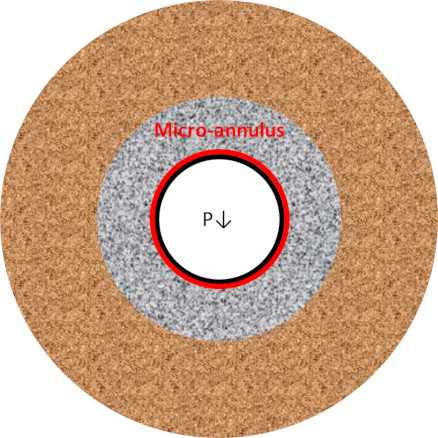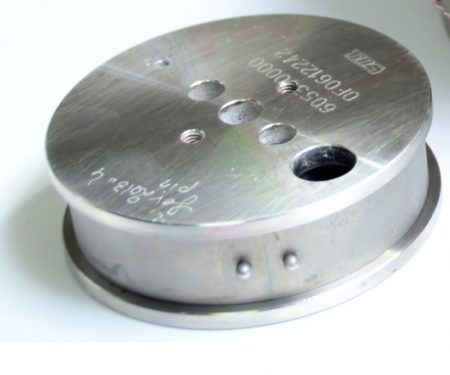
Chemical shrinkage of hydraulic binders
September 4, 2018
Expanding agents for improved zonal isolation
November 19, 2018Bulk volume change of hydrating Portland cement systems
The third article in the series linking chemical shrinkage of cement systems to well integrity and zonal isolation. The articles in the series:
- Introduction: background to cement chemistry and hydration reactions
- Chemical shrinkage: what it is, how to calculate it and how to measure it?
- Bulk volume change: how do well conditions affect the bulk volume changes of cement and what are the consequences for zonal isolation?
- Expanding agents: how can they be used to improve zonal isolation?
As has been seen previously chemical shrinkage is unavoidable in the hydration and setting of Portland cement-based systems. However, the effect of chemical shrinkage on the bulk volume changes will depend significantly on the conditions during setting.
Autogenous shrinkage
Autogenous shrinkage is defined as the bulk shrinkage of a closed, isothermal, cementitious material system not subjected to external forces. A more general term is autogenous deformation (or strain), which covers cases where there is a net bulk volume increase.
For cement slurries used in oil well cementing autogenous strain is what is measured in the membrane test described in API RP 10B-5.
As hydration occurs there is a loss of volume as discussed previously. At very early stages the bulk volume change of the cement (in a sealed environment) follows the chemical shrinkage until a rigid structure develops within the cement slurry. This is the point where enough cement has hydrated to form a long-range network of hydration products, un-hydrated cement and fillers. At this stage in sealed conditions the continued hydration of the cement consumes free water and leads to emptying of the pore structure, the largest pores emptying first. Menisci occur at the interface between water and vapour filled pores generating tensile stresses that lead to bulk shrinkage. A few equations that describe the physics of the situation.
The Kelvin equation
The relative humidity (RH) or vapour pressure above a meniscus in a cylindrical pore of radius r is given by the Kelvin equation:
ln(RH)= -2γVm/rRT
where:
γ is the surface tension of the pore solution (N/m)
Vm is the molar volume of the pore solution (m3/mol)
r is the radius of the largest water filled cylindrical pore (m)
R is the universal gas constant – 8.314 J/(mol K)
T is the absolute temperature (K)
This equation assumes perfect wetting of the surfaces by the pore fluid (contact angle = 0°).
This equation shows that as vapour filled pores are created, the relative humidity inside the cement decreases. The rate of hydration will decrease with decreasing relative humidity and will virtually stop at relative humidity <80%. Assuming fresh water this equation indicates that pores with radii down to around 5 nm will be emptied.
The Young-Laplace equation
Capillary tension (σcap) in the pore liquid is given by:
σcap = 2γcosθ/r
where θ is the contact angle. For this case we assume perfect wetting, θ=0 and therefore cosθ = 1. A pore radius of 5 nm will give a capillary pressure of around 30 MPa assuming freshwater and perfect wetting.
As hydration progresses, and more water is consumed, smaller and smaller pores are emptied. This leads to a reduction in relative humidity and an increase in capillary tension.
In turn the capillary tension creates tensile stresses in the setting cement leading to bulk volume decreases. As hydration continues the rate of bulk volume shrinkage decreases because increasing capillary tension is offset by the increasing bulk modulus of the cement system.
References
A few of the very many references on the subject of bulk volume changes in hydrating Portland cement systems.
- “Mitigation strategies for autogenous shrinkage cracking,” D.P.Bentz and O.M.Jensen, Cement and Concrete Composites, Volume 26, Issue 6, August 2004, Pages 677-685.
- “Is long-term autogenous shrinkage a creep phenomenon induced by capillary effects due to self-desiccation?” Abudushalamu Aili, Matthieu Vandamme, Jean-Michel Torrenti and Benoit Masson, Cement and Concrete Research, Volume 108, June 2018, Pages 186-200.
- “Measurement of Volume Change in Cementitious Materials at Early Ages: Review of Testing Protocols and Interpretation of Results,” Gaurav Sant, Pietro Lura and Jason Weiss, Transportation Research Record: Journal of the Transportation Research Board, Volume 1979, 2006, Pages 21-29.
Considerations for Oil Well Cementing
In primary cementing applications several factors can affect the volume changes of setting cement and, even ignoring the fact that most times isothermal conditions are not met, autogenous shrinkage may only be important in a few situations.
With cement placed in the open hole the interactions between cement and rock can be complex. Permeable formations may provide a water source to maintain the saturation of the cement, once the cement starts to set. As can be seen from the equations given above if the cement remains fully saturated during hydration then there will not be any driving force for bulk shrinkage.
In other cases, such as with shales, there may be some fluid movement depending on the respective water activities but also some chemical interactions at the interface. With narrow annuli interactions at the cement rock interface are likely to affect the entire cement thickness.
Situations where autogenous shrinkage may be an important factor for oil well cements:
- Cement placed between two casing strings
- Cement plugs placed inside casing.
In both these cases there is no possible exchange of fluid or chemical interaction. Even with cement plugs placed in open hole, autogenous shrinkage may play an important role in isolation as interactions at the formation interface will affect only a part of the cement plug.
It is possible to optimise slurry designs to mitigate the effect of autogenous shrinkage. Typical oilfield cement slurries have higher water to cement ratios (0.42 or higher) than concrete used in civil engineering. This gives rise to a coarser pore structure and consequently lower capillary pressure and lower autogenous shrinkage. It is also possible to design specialised oilfield cement slurries with very high water to cement ratios (0.83 reported in SPE97347) whilst maintaining suitable properties for well cementing.
Methods used to mitigate autogenous shrinkage in civil engineering applications can also be tried. For example the addition of surfactants to reduce surface tension of the pore fluid (Shrinkage reducing agents – SRA – in civil engineering) can be considered. Indeed additives such as latex, used for gas migration control, contain surfactants which may have a side benefit of acting as an SRA.
In concrete super-absorbent polymers or porous particulates are sometimes used to provide internal reservoirs of water, increasing the pore size of the empty pores and thus reducing the capillary pressure. This method is not generally used in oil well cementing, probably because of difficulties control the cement slurry properties.
One common method of mitigating shrinkage in cements for O&G wells is to use expanding agents. This is the subject of the next article.


